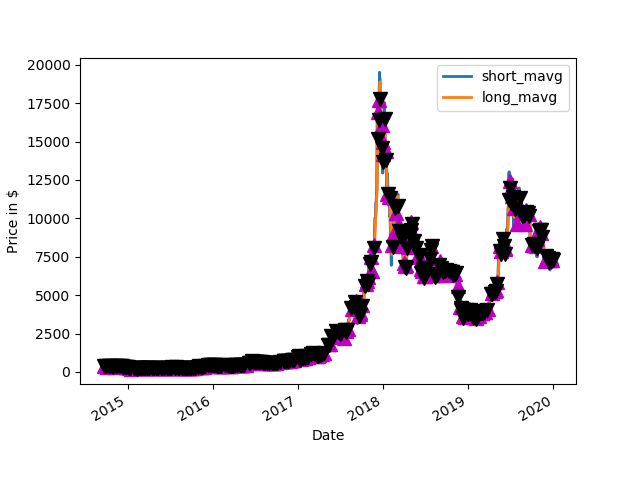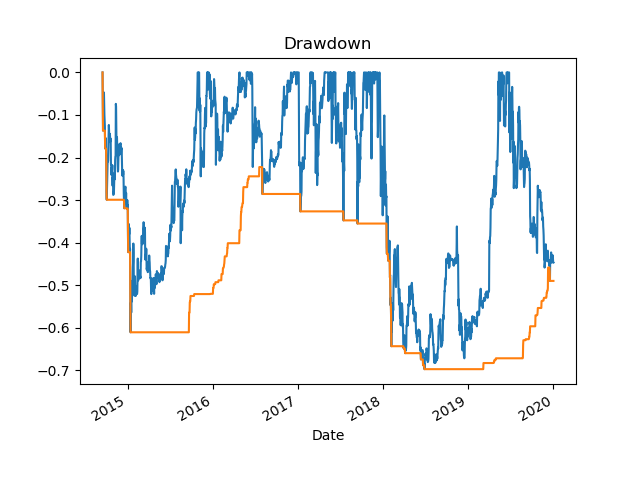As the great and powerful Satoshi Nakamoto once said, “If you don’t believe me or don’t get it, I don’t have time to try to convince you, sorry.”
For a while I have used a piece of code that started as back-testing code and forked it to produce output whenever BTC-USD makes a 2 standard deviation move in price up or down. Basically I manually adjusted the threshold that is normally a fluid value in backtesting to a fixed value, so that 95% of the time a U for Up, or D for Down move is not recorded, It’s counted as O, which means nothing interesting happened and is not printed. CRON runs this hourly and the machine responsible for trading runs 24/7 and collects prices, since August 28,2018. It even plays a sound when one of these outlier moves occurs.
Here are a few lines from the end of the output….
2024-01-03 16:00:02.618000 63874 42197.47 43004.35 U 2 1.02
2024-01-03 19:00:03.434000 63877 42923.71 42269.13 D 2 0.98
O: 43795 95.0%
D: 1165 2.5%
U: 1148 2.5%
The top two lines have a time stamp followed by a tick count, this is where it is in the data set, in order, adding 1 per hour. Next are the two prices, the starting and ending prices, U or D, signalling which way it just went. The next number shows how many hours have elapsed since the last radical move followed by the scale of the move. This is a rounded number that shows what number would be required to multiply the first price to get the current price, how big a move in other words.
2 Standard Deviations for Bitcoin
Daily
I recently adjusted the calibration threshold as BTC is settling down into less radical swings as time goes on. Currently it is….
THRESHOLD = 0.01459 # 0.0156
…which means on an hourly basis a 1.459% move registers as a 2 standard deviation move. It was 1.56% earlier this year, so volatility is trending down over time.
Can that be tradable, not likely as fees and slippage would most likely eat up the 1.459%, granted some higher swings do occur and I have pondered this. What is you bought all the big down moves and sold on the big up moves. Sounds good in theory and would most likely only work in an up market or else, you just wind up buying at bad entries and ‘bag hold’ too much at a loss until the next bull run.
Weekly
I got the idea to look at a daily and weekly time frame. Weekly is such a short output that I will paste it here….
Start of Data: 2018-09-05
Lines of input data: 279
Lines to process: 279
2018-11-21 05:00:11.243000 17809 6268.44 4452.68 D 10 0.71
2019-04-03 04:00:15.519000 17828 3976.88 5050.01 U 18 1.27
2019-05-15 04:00:15.266000 17834 5782.6 8063.78 U 5 1.39
2019-06-26 04:00:16.011000 17840 9139.01 12228.39 U 5 1.34
2019-07-17 04:00:14.972000 17843 12983.74 9411.06 D 2 0.72
2020-03-15 04:00:05.033000 17878 8749.01 5168.75 D 34 0.59
2020-08-02 04:00:06.489000 17898 9686.6 12000.0 U 19 1.24
2020-12-20 05:00:12.005000 17918 18865.0 23460.71 U 19 1.24
2021-01-03 05:00:14.866000 17920 26732.29 33231.68 U 1 1.24
2021-02-14 05:00:19.359000 17926 38365.06 47607.09 U 5 1.24
2021-03-14 05:00:09.349000 17930 49437.95 61191.88 U 3 1.24
2021-08-01 04:00:03.128000 17950 34192.29 42461.2 U 19 1.24
2022-06-19 04:00:02.056000 17996 27515.55 18282.06 D 45 0.66
2023-03-19 04:00:02.137000 18035 20598.23 27282.54 U 38 1.32
D: 4 1.4%
O: 264 95.0%
U: 10 3.6%
A few things to note:
- There is asymmetry as the market has in general been rising since 2018, so there are only 4 ‘large’ down moves and 10 up. 1.4% weeks are up moves, 3.6% are down. The number after U and D is the weeks between moves.
- Note the magnitude of the moves. They are truly massive. As the threshold is now 0.235.
- Note that the 5 sequential up moves in a row 2020-2021 barely made in over the threshold at 1.24
- Make note of the fact that Bitcoin is calming down over the years by looking at how many times per year it makes these epic moves.
- Last but not least. I wonder if the what the linear regression of the prices would tell. Perhaps good targets for the future?

From now on, I will monitor this more carefully. As one can see, entry and exit although infrequent would have lead to stellar performance. I’ve been doing crypto TA and writing related code for almost 6 years now and it is still interesting that some new price relationships can be sussed out.
Looking ahead
It’s a guess buy based on the chart above it will be worth seeing if there is a pullback below the price of the blue linear regression termination, 37K-ish down to the termination of the D and E price lines 20598.23 27282.54. It will be interesting to followup on this.
Daily
For daily the THRESHOLD = 0.076, so that means greater that 7.6% moves are counted. Below I have pasted in the 2022 to 2023 results. 2022 being terrible and 2023 awesome. I let the reader ponder the readability of these price moves.
2022-02-05 05:00:03.175000 19053 37326.16 41505.25 U 62 1.11
2022-02-24 05:00:04.472000 19072 38042.82 35122.81 D 18 0.92
2022-02-25 05:00:04.643000 19073 35122.81 38740.11 U 0 1.1
2022-03-01 05:00:06.659000 19077 37830.34 43388.77 U 3 1.15
2022-03-09 05:00:02.706000 19085 38554.62 41656.28 U 7 1.08
2022-05-06 04:00:02.780000 19143 39727.55 36446.18 D 57 0.92
2022-05-10 04:00:02.150000 19147 33556.09 30678.51 D 3 0.91
2022-05-12 04:00:02.124000 19149 31191.22 28234.93 D 1 0.91
2022-05-13 04:00:02.622000 19150 28234.93 30523.85 U 0 1.08
2022-06-14 04:00:02.293000 19182 25483.35 22074.01 D 31 0.87
2022-06-17 04:00:02.808000 19185 22182.06 20359.29 D 2 0.92
2022-06-19 04:00:02.056000 19187 20424.2 18282.06 D 1 0.9
2022-06-20 04:00:02.514000 19188 18282.06 19961.12 U 0 1.09
2022-07-08 04:00:02.559000 19206 20465.35 22125.65 U 17 1.08
2022-07-28 04:00:01.952000 19226 21076.25 23137.12 U 19 1.1
2022-09-14 04:00:02.511000 19274 22235.95 20324.97 D 47 0.91
2022-11-10 05:00:02.217000 19331 18242.1 16433.61 D 56 0.9
2023-01-14 05:00:02.777000 19396 18820.73 20901.76 U 64 1.11
2023-01-21 05:00:02.053000 19403 20991.31 22602.95 U 6 1.08
2023-02-16 05:00:02.079000 19429 22092.46 24634.33 U 25 1.12
2023-03-10 05:00:02.124000 19451 21737.7 19877.69 D 21 0.91
2023-03-13 04:00:01.980000 19454 20598.23 22326.45 U 2 1.08
2023-03-14 04:00:02.715000 19455 22326.45 24517.05 U 0 1.1
2023-08-18 04:00:02.811000 19612 28619.6 26395.38 D 156 0.92
2023-10-24 03:00:02.742000 19679 30389.89 34553.97 U 66 1.14
D: 46 2.4%
O: 1856 95.0%
U: 51 2.6%
Looking at the plot for daily and remember this does not mean the X axis is time, just moves, even though it does look similar to a price -vs- time chart. In this case both regression lines overlap 100%.

Looking ahead
This is a guess but looking at this I am inclined to think a pullback between the regression line termination at 40K and the termination of the D and E price lines at 30 and 35K would be something to keep and eye out for.
Alternative Daily Move Chart
Taking the geometric mean of the daily and weekly thresholds, the result is 0.133. This produces using a daily tick an output that has as many large price moves as the weekly chart and can be seen as an alternative while slightly different, lines up similarly on the chart. The moves are roughly 3 standard deviation moves in this case.
Start of Data: 2018-08-30
Lines of input data: 1955
Lines to process: 1955
2018-11-20 05:00:17.949000 17880 5495.99 4641.55 D 81 0.84
2018-11-25 05:00:13.877000 17885 4301.01 3632.02 D 4 0.84
2019-04-03 04:00:15.519000 18014 4177.0 5050.01 U 128 1.21
2019-05-14 04:00:15.992000 18055 7016.99 7963.14 U 40 1.13
2019-06-28 04:00:15.313000 18100 12821.64 11110.99 D 44 0.87
2019-10-26 04:00:17.489000 18220 7455.01 9599.17 U 119 1.29
2020-03-13 04:00:04.431000 18359 7659.09 5385.44 D 138 0.7
2020-03-20 04:00:04.240000 18366 5301.62 6163.32 U 6 1.16
2020-04-30 04:00:04.743000 18407 7821.73 9291.9 U 40 1.19
2021-01-06 05:00:08.853000 18658 30880.51 35456.93 U 250 1.15
2021-02-09 05:00:09.512000 18692 38618.01 46888.08 U 33 1.21
2022-03-01 05:00:06.659000 19077 37830.34 43388.77 U 384 1.15
2022-06-14 04:00:02.293000 19182 25483.35 22074.01 D 104 0.87
2023-10-24 03:00:02.742000 19679 30389.89 34553.97 U 496 1.14
U: 9 0.5%
O: 1940 99.3%
D: 5 0.3%

Code
Code is on Github, it is quite a hack as it was made from pieces of other backtest code and production code that has not been cleaned or refactored.
https://github.com/erickclasen/cbpro-cli-tools/blob/main/uod.py
















